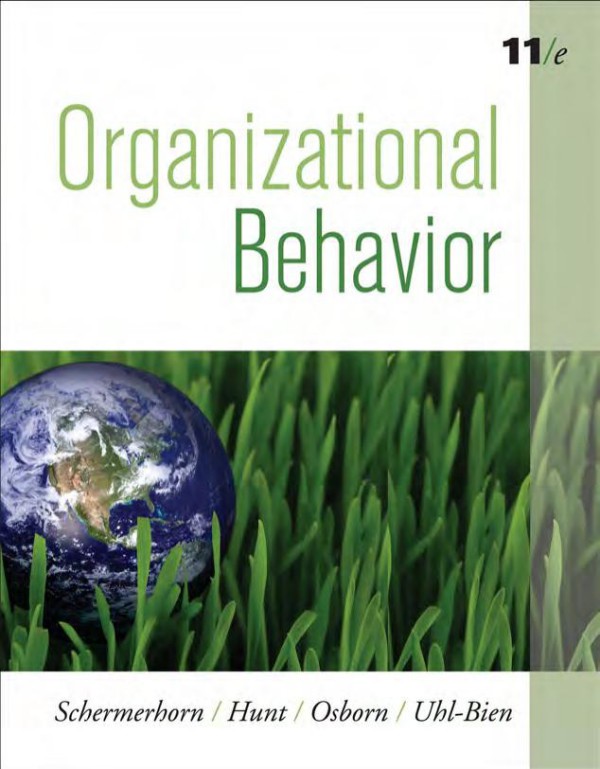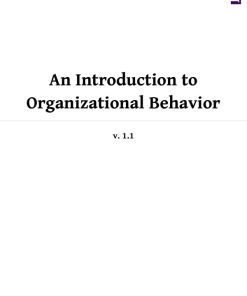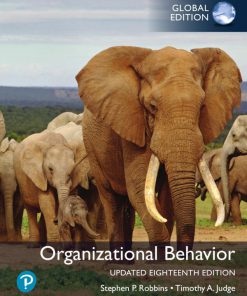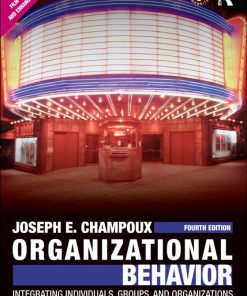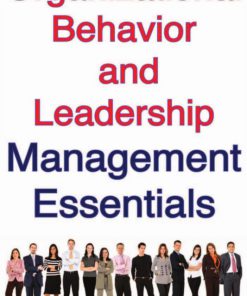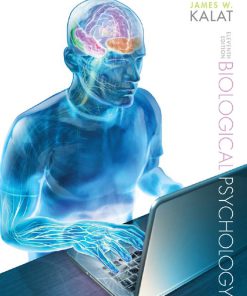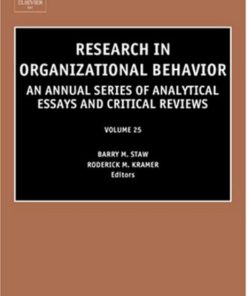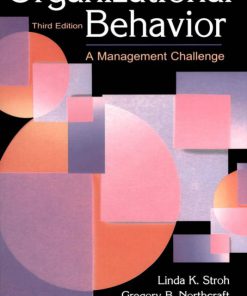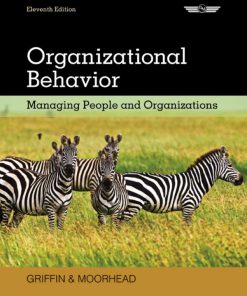Organizational Behavior 11th Edition by John Schermerhorn, James Hunt, Richard Osborn 9780470294413
$50.00 Original price was: $50.00.$25.00Current price is: $25.00.
Authors:Schermerhorn, John R. , Series:Management [797] , Author sort:Schermerhorn, John R. , Languages:Languages:eng , Published:Published:Jul 2010 , Publisher:Wiley
Organizational Behavior 11th Edition by John Schermerhorn, James Hunt, Richard Osborn – Ebook PDF Instant Download/Delivery. 9780470294413
Full download Organizational Behavior 11th Edition after payment
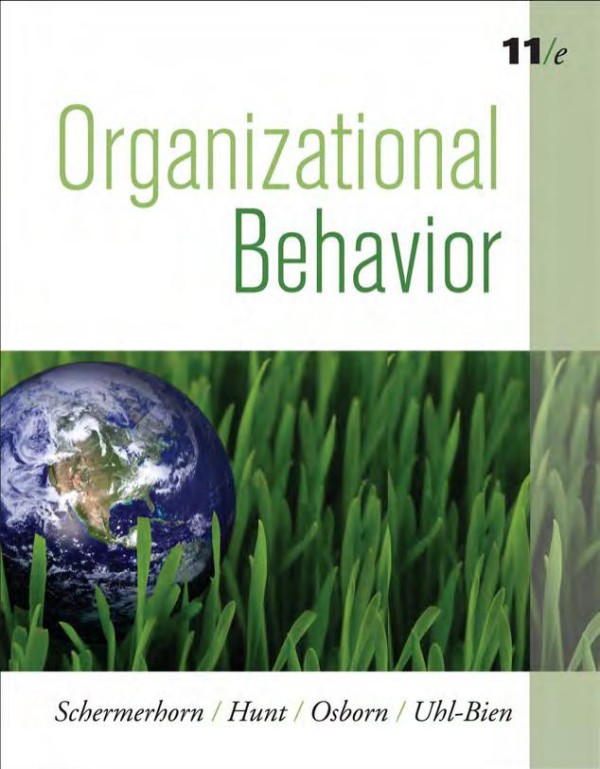
Product details:
ISBN 13: 9780470294413
Author: John R. Schermerhorn, James G. Hunt, Richard N. Osborn
Known throughout the world for sound pedagogy, research, and theory and well-loved for a rich framework of personal and organizational skills, Organizational Behavior presents students with a full portfolio of skills that will enable them to thrive in whatever area of business they eventually choose. The authors’ new Eleventh Edition places emphases on ethics, leadership, and sustainability—with the same organization, content, and cohesive voice that guides students in the right direction.
Organizational Behavior 11th Table of contents:
1. Introducing Organizational Behavior
1.1. Introducing Organizational Behavior
1.1.1. Importance of Organizational Behavior
1.1.2. Scientific Foundations of Organizational Behavior
1.1.3. Shifting Paradigms of Organizational Behavior
1.2. Organizations as Work Settings
1.2.1. Organizational Purpose, Mission, and Strategy
1.2.2. Organizational Environments and Stakeholders
1.2.3. Organizational Cultures
1.2.4. Diversity and Multiculturalism
1.3. Organizational Behavior and Management
1.3.1. The Management Process
1.3.2. Managerial Activities, Roles, and Networks
1.3.3. Managerial Skills and Competencies
1.3.4. Moral Management
1.4. Learning about Organizational Behavior
1.4.1. Learning and Experience
1.4.2. Learning Styles
1.4.3. Learning Guide to Organizational Behavior 11/E
1.5. Resources in The OB Skills Workbook
1.6. Chapter 1 study guide: Summary Questions and Answers
1.7. Key Terms
1.8. Self-Test 1
1.8.1. Multiple Choice
1.8.2. Short Response
1.8.3. Applications Essay
2. Individual Differences, Values, and Diversity
2.1. Individual Differences
2.1.1. Self-Awareness and Awareness of Others
2.1.2. Components of Self
2.1.3. Development of Self
2.2. Personality
2.2.1. Big Five Personality Traits
2.2.2. Social Traits
2.2.3. Personal Conception Traits
2.2.4. Emotional Adjustment Traits
2.3. Personality and Stress
2.3.1. Sources of Stress
2.3.2. Outcomes of Stress
2.3.3. Managing Stress
2.4. Values
2.4.1. Sources of Values
2.4.2. Types of Values
2.4.3. Values across National Cultures
2.5. Diversity
2.5.1. Importance of Diversity
2.5.2. Types of Diversity
2.5.3. Valuing and Supporting Diversity
2.6. Resources in The OB Skills Workbook
2.7. Chapter 2 study guide: Summary Questions and Answers
2.8. Key Terms
2.9. Self-Test 2
2.9.1. Multiple Choice
2.9.2. Short Response
2.9.3. Applications Essay
3. Emotions, Attitudes, and Job Satisfaction
3.1. Foundations of Emotions and Moods
3.1.1. Emotions
3.1.2. Emotional Intelligence
3.1.3. Types of Emotions
3.1.4. Moods
3.2. Emotions and Moods in Organizations
3.2.1. Emotion and Mood Contagion
3.2.2. Emotional Labor
3.2.3. Emotions and Moods across Cultures
3.2.4. Emotions and Moods as Affective Events
3.2.5. Functions of Emotions and Moods
3.3. Attitudes
3.3.1. Components of Attitudes
3.3.2. Attitudes and Behavior
3.3.3. Attitudes and Cognitive Consistency
3.3.4. Types of Job Attitudes
3.4. Job Satisfaction
3.4.1. Components of Job Satisfaction
3.4.2. Job Satisfaction Findings
3.4.3. Job Satisfaction and Behavior
3.4.4. Job Satisfaction and Performance
3.5. Resources in The OB Skills Workbook
3.6. Chapter 3 study guide: Summary Questions and Answers
3.7. Key Terms
3.8. Self-Test 3
3.8.1. Multiple Choice
3.8.2. Short Response
3.8.3. Applications Essay
4. Perception, Attribution, and Learning
4.1. The Perception Process
4.1.1. Factors Influencing Perception
4.1.2. Stages of the Perception Process
4.1.3. Perception and Impression Management
4.1.4. Social Networks
4.2. Common Perceptual Distortions
4.2.1. Stereotypes
4.2.2. Halo Effects
4.2.3. Selective Perception
4.2.4. Projection
4.2.5. Contrast Effects
4.2.6. Self-Fulfilling Prophecies
4.3. Perception and Attribution
4.3.1. Importance of Attributions
4.3.2. Attribution Errors
4.3.3. Attributions across Cultures
4.3.4. Attribution and Social Learning
4.4. Learning by Reinforcement
4.4.1. Classical and Operant Conditioning
4.4.2. Law of Effect
4.4.3. Positive Reinforcement
4.4.4. Negative Reinforcement
4.4.5. Punishment
4.4.6. Extinction
4.4.7. Reinforcement Pros and Cons
4.5. Resources in The OB Skills Workbook
4.6. Chapter 4 study guide: Summary Questions and Answers
4.7. Key Terms
4.8. Self-Test 4
4.8.1. Multiple Choice
4.8.2. Short Response
4.8.3. Applications Essay
5. Motivation Theories
5.1. What Is Motivation?
5.1.1. Motivation Defined
5.1.2. Types of Motivation Theories
5.1.3. Motivation across Cultures
5.2. Needs Theories of Motivation
5.2.1. Hierarchy of Needs Theory
5.2.2. ERG Theory
5.2.3. Acquired Needs Theory
5.2.4. Two-Factor Theory
5.3. Equity Theory of Motivation
5.3.1. Equity and Social Comparisons
5.3.2. Equity Theory Predictions
5.3.3. Equity Theory and Organizational Justice
5.4. Expectancy Theory of Motivation
5.4.1. Expectancy Terms and Concepts
5.4.2. Expectancy Theory Predictions
5.4.3. Expectancy Implications and Research
5.5. Goal-Setting Theory of Motivation
5.5.1. Motivational Properties of Goals
5.5.2. Goal-Setting Guidelines
5.5.3. Goal Setting and the Management Process
5.6. Resources in The OB Skills Workbook
5.7. Chapter 5 study guide: Summary Questions and Answers
5.8. Key Terms
5.9. Self-Test 5
5.9.1. Multiple Choice
5.9.2. Short Response
5.9.3. Applications Essay
6. Motivation and Performance
6.1. Motivation and Rewards
6.1.1. Integrated Model of Motivation
6.1.2. Intrinsic and Extrinsic Rewards
6.1.3. Pay for Performance
6.1.4. Pay for Skills
6.2. Performance Management
6.2.1. Performance Measurement Process
6.2.2. Performance Appraisal Methods
6.2.3. Performance Appraisal Errors
6.3. Job-Design Alternatives
6.3.1. Scientific Management
6.3.2. Job Enlargement and Job Rotation
6.3.3. Job Enrichment
6.3.4. Job Characteristics Model
6.4. Alternative Work Schedules
6.4.1. Compressed Work Weeks
6.4.2. Flexible Working Hours
6.4.3. Job Sharing
6.4.4. Telecommuting
6.4.5. Part-Time Work
6.5. Resources in The OB Skills Workbook
6.6. Chapter 6 study guide: Summary Questions and Answers
6.7. Key Terms
6.8. Self-Test 6
6.8.1. Multiple Choice
6.8.2. Short Response
6.8.3. Applications Essay
7. Teams in Organizations
7.1. Teams in Organizations
7.1.1. Teams and Teamwork
7.1.2. What Teams Do
7.1.3. Organizations as Networks of Teams
7.1.4. Cross-Functional and Problem-Solving Teams
7.1.5. Virtual Teams
7.1.6. Self-Managing Teams
7.2. Team Effectiveness
7.2.1. Criteria of an Effective Team
7.2.2. Synergy and Team Benefits
7.2.3. Social Loafing and Team Problems
7.3. Stages of Team Development
7.3.1. Forming Stage
7.3.2. Storming Stage
7.3.3. Norming Stage
7.3.4. Performing Stage
7.3.5. Adjourning Stage
7.4. Foundations of Team Performance
7.4.1. Team Inputs
7.4.2. Diversity and Team Performance
7.4.3. Team Processes
7.5. Resources in The OB Skills Workbook
7.6. Chapter 7 study guide: Summary Questions and Answers
7.7. Key Terms
7.8. Self-Test 7
7.8.1. Multiple Choice
7.8.2. Short Response
7.8.3. Applications Essay
8. Teamwork and Team Performance
8.1. High-Performance Teams
8.1.1. Characteristics of High-Performance Teams
8.1.2. The Team-Building Process
8.1.3. Team-Building Alternatives
8.2. Improving Team Processes
8.2.1. Entry of New Members
8.2.2. Task and Maintenance Leadership
8.2.3. Roles and Role Dynamics
8.2.4. Team Norms
8.2.5. Team Cohesiveness
8.2.6. Inter-Team Dynamics
8.3. Improving Team Communications
8.3.1. Communication Networks
8.3.2. Proxemics and Use of Space
8.3.3. Communication Technologies
8.4. Improving Team Decisions
8.4.1. Ways Teams Make Decisions
8.4.2. Assets and Liabilities of Team Decisions
8.4.3. Groupthink Symptoms and Remedies
8.4.4. Team Decision Techniques
8.5. Resources in The OB Skills Workbook
8.6. Chapter 8 Study guide: Summary Questions and Answers
8.7. Key Terms
8.8. Self-Test 8
8.8.1. Multiple Choice
8.8.2. Short Response
8.8.3. Applications Essay
9. Decision Making and Creativity
9.1. The Decision-Making Process
9.1.1. Steps in Decision Making
9.1.2. Ethical Reasoning and Decision Making
9.1.3. Types of Decisions
9.1.4. Decision Environments
9.1.5. Risk Management in Decision Making
9.2. Decision-Making Models
9.2.1. Classical Decision Model
9.2.2. Behavioral Decision Model
9.2.3. Garbage Can Decision Model
9.2.4. Intuitive Decision Model
9.3. Decision-Making Traps and Issues
9.3.1. Judgmental Heuristics
9.3.2. Decision Biases
9.3.3. Knowing When to Decide
9.3.4. Knowing Who to Involve
9.3.5. Knowing When to Quit
9.4. Creativity in Decision Making
9.4.1. Stages of Creative Thinking
9.4.2. Personal Creativity Drivers
9.4.3. Team Creativity Drivers
9.5. Resources in The OB Skills Workbook
9.6. Chapter 9 study guide: Summary Questions and Answers
9.7. Key Terms
9.8. Self-Test 9
9.8.1. Multiple Choice
9.8.2. Short Response
9.8.3. Applications Essay
10. Conflict and Negotiation
11. Communication and Collaboration
11.1. The Nature of Communication
11.1.1. The Communication Process
11.1.2. Feedback and Communication
11.1.3. Nonverbal Communication
11.2. Interpersonal Communication
11.2.1. Communication Barriers
11.2.2. Active Listening
11.2.3. Cross-Cultural Communication
11.3. Organizational Communication
11.3.1. Communication Channels
11.3.2. Communication Flows
11.3.3. Status Effects
11.4. Collaborative Work Environments
11.4.1. Collaboration Technologies
11.4.2. Interactional Transparency
11.4.3. Supportive Communication Principles
11.5. Resources in The OB Skills Workbook
11.6. Chapter 11 study guide: Summary Questions and Answers
11.7. Key Terms
11.8. Self-Test 11
11.8.1. Multiple Choice
11.8.2. Short Response
11.8.3. Applications Essay
12. Power and Politics
13. Leadership Essentials
14. Leadership Challenges and Organizational Change
15. Organizational Culture and Innovation
15.1. Organizational Culture
15.1.1. Functions of Organizational Culture
15.1.2. Subcultures and Countercultures
15.1.3. National Culture and Corporate Culture
15.2. Understanding Organizational Cultures
15.2.1. Layers of Cultural Analysis
15.2.2. Stories, Rites, Rituals, and Symbols
15.2.3. Cultural Rules and Roles
15.2.4. Shared Values, Meanings, and Organizational Myths
15.3. Innovation in Organizations
15.3.1. The Process of Innovation
15.3.2. Product and Process Innovations
15.3.3. Balancing Exploration and Exploitation
15.4. Managing Organizational Culture and Innovation
15.4.1. Management Philosophy and Strategy
15.4.2. Building, Reinforcing, and Changing Culture
15.4.3. Tensions Between Cultural Stability and Innovation
15.5. Resources in The OB Skills Workbook
15.6. Chapter 15 study guide: Summary Questions and Answers
15.7. Key Terms
15.8. Self-Test 15
15.8.1. Multiple Choice
15.8.2. Short Response
15.8.3. Applications Essay
16. Organizational Goals and Structures
16.1. Organizational Goals
16.1.1. Societal Goals
16.1.2. Output Goals
16.1.3. Systems Goals
16.2. Hierarchy and Control
16.2.1. Organizations as Hierarchies
16.2.2. Controls Are a Basic Feature
16.2.3. Centralization and Decentralization
16.3. Organizing and Coordinating Work
16.3.1. Traditional Types of Departments
16.3.2. Coordination
16.4. Bureaucracy and Beyond
16.4.1. Mechanistic Structures and the Machine Bureaucracy
16.4.2. Organic Structures and the Professional Bureaucracy
16.4.3. Hybrid Structures
16.5. Resources in The OB Skills Workbook
16.6. Chapter 16 study guide: Summary Questions and Answers
16.7. Key Terms
16.8. Self-Test 16
16.8.1. Multiple Choice
16.8.2. Short Response
16.8.3. Applications Essay
17. Strategy, Technology, and Organizational Design
17.1. Strategy and Organizational Learning
17.1.1. Strategy
17.1.2. Organizational Learning
17.1.3. Linking Strategy and Organizational Learning
17.2. Strategy and Organizational Design
17.2.1. Organizational Design and Strategic Decisions
17.2.2. Organizational Design and Co-Evolution
17.2.3. Organizational Design and Growth
17.3. Technology and Organizational Design
17.3.1. Operations Technology and Organizational Design
17.3.2. Adhocracy as a Design Option for Innovation and Learning
17.3.3. Information Technology
17.4. Environment and Organizational Design
17.4.1. Environmental Complexity
17.4.2. Using Networks and Alliances
17.5. Resources in The OB Skills Workbook
17.6. Chapter 17 study guide: Summary Questions and Answers
17.7. Key Terms
17.8. Self-Test 17
17.8.1. Multiple Choice
17.8.2. Short Response
17.8.3. Applications Essay
People also search for Organizational Behavior 11th :
is organization a behavior
what is organizational change in organizational behavior
what is organizational behavior (ob)
what is the essence of organizational behavior

